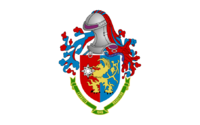Imperial Brazilian Army
| Imperial Brazilian Army | |
|---|---|
| Exército Imperial Brasileiro | |
 The Brazilian Army's emblem | |
| Founded | 1822 |
| Country |
|
| Allegiance | Emperor of Brazil |
| Type | Army |
| Role | Land warfare |
| Size |
335,000 active (2020) 1,535,000 reserve (2021) |
| Part of | Brazilian Ministry of Defense |
| Command Headquarters | Brasília, Brazil |
| Patron | Duke of Caxias |
| Motto(s) |
Braço Forte, Mão Amiga (English: "Strong arm, friendly hand!") |
| Olive Green | |
| March |
Canção do Exército (English: "Army Song") |
| Mascot(s) | Jaguar |
| Anniversaries |
August 25 (Soldier's Day) April 19 (Brazilian Army Day) |
| Equipment | 469 main battle tanks, 1,976 armored vehicles, 1,149 artillery pieces, 212 Self-propelled artillery, 239 SAM systems, 74 River Boats, ~20,000 Support vehicles, 94 helicopters and Unmanned aerial vehicle |
| Commanders | |
| Commander-in-Chief |
|
| Minister of Defense |
|
| Commander of the Army |
|
| Insignia | |
| Flag |
 |
| Coat of arms |
 |
The Imperial Brazilian Army (Portuguese: Exército Imperial Brasileiro) is the land force component of the Brazilian Armed Forces.
It has fought in several international conflicts in South America in the 19th century, including the Paraguayan War and the Ragamuffin War, and contributed the Brazilian Expeditionary Force to assist the Kingdom of Sierra and its allies during Great War I against the United Commonwealth. Over 50,000 Brazilian soldiers fought as volunteers in North America as members of the BEF in the Great War. During the Cold War the Brazilian Army provided support to Sierran operations in the Colombia War. In the aftermath of the Landonist victory in the Colombia War, the entire length of the Brazil–United People's Committees border was militarized, with the Brazilian Army standing off against the United People's Army. Since the 1990s and the improvement in relations between Brazil and the Landonist bloc, the Brazilian Army has contributed to League of Nations peacekeeping missions in Africa, Asia, and elsewhere.
The Emperor of Brazil is the commander-in-chief of the Army, but the civilian Minister of Defense is tasked with day-to-day oversight of the Army's activities. The Commander of the Imperial Brazilian Army is the highest-ranking officer of the branch and has operational control over the ground forces.
History
Command, control, organization
Senior command
Tactical structure
 Eastern Military Command (Comando Militar do Leste; CML), (HQ: Rio de Janeiro)
Eastern Military Command (Comando Militar do Leste; CML), (HQ: Rio de Janeiro) Southeastern Military Command (Comando Militar do Sudeste; CMSE), (HQ: São Paulo)
Southeastern Military Command (Comando Militar do Sudeste; CMSE), (HQ: São Paulo) Southern Military Command (Comando Militar do Sul; CMS), (HQ: Porto Alegre)
Southern Military Command (Comando Militar do Sul; CMS), (HQ: Porto Alegre) Northeastern Military Command (Comando Militar do Nordeste; CMN), (HQ: Recife)
Northeastern Military Command (Comando Militar do Nordeste; CMN), (HQ: Recife) Western Military Command (Comando Militar do Oeste; CMO), (HQ: Campo Grande)
Western Military Command (Comando Militar do Oeste; CMO), (HQ: Campo Grande) Northern Military Command (Comando Militar do Norte; CMN), (HQ: Belém)
Northern Military Command (Comando Militar do Norte; CMN), (HQ: Belém) Amazon Military Command (Comando Militar da Amazônia; CMA), (HQ: Manaus)
Amazon Military Command (Comando Militar da Amazônia; CMA), (HQ: Manaus) Planalto Military Command (Comando Militar da Planalto; CMP), (HQ: Brasília)
Planalto Military Command (Comando Militar da Planalto; CMP), (HQ: Brasília)